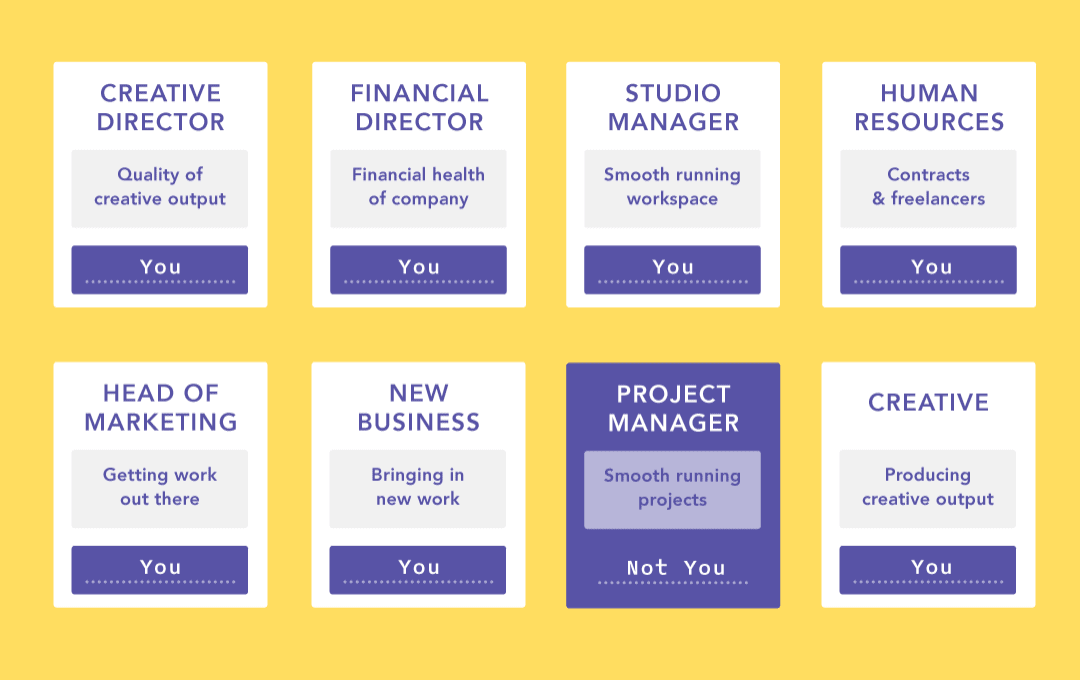
When you’re starting out in this industry, it’s easy to find inspiration that will point you towards style and software how-tos. Several years in, however, many face murkier questions on how to proceed. Should you start a studio? If so, how does one begin? How big should that studio be? Business self-help books can be useful. But they often are not specific enough to the quirks of an ever-evolving design industry, where the very definition of a “studio” is open to interpretation.
Looking around for models, one studio that I admire, from both a business and creative perspective, is Animade. They’ve seemed to find that rare symbiosis between client-facing work and customer-facing products like Boords. Their hybrid approach is why I found Animade co-Founder, James Chambers’ post — “Growing a Studio, the hard way” — so enticing. In the piece, James gives practical advice on how Animade started to scale successfully.
We’ve included that original Boords post here, below. We also caught up with James to gain bonus insight on his views as a business owner.
Q&A with James Chambers
Tell me a bit about your background. As an Animade founder, you’re clearly thinking a lot about business. But you’re also a programmer who still gets his hands dirty, creatively.
I started out studying traditional graphic design, then moved into the interactive side of things from there. The first project I took on with Animade/Boords co-founder Tom Judd was a social network for student artists called 5oup. Tom and I eventually ended up co-founding Animade in 2010. Although neither of us has any formal business training, it’s helped that we’ve always enjoyed getting our hands dirty in every aspect of keeping a company running. I think that willingness to move around between a lot of different specialisms and figure things out has been a big help.
I’m curious if there was a particular impetus for this post? Any particular reason why you wanted to share some of the inner-workings of how Animade ticks?
Through Boords I speak with a lot of creatives and small business owners. During those conversations, it’s become clear just how many people are dealing with the same problems we are. The motivation for the post was to share what’s worked (or hasn’t) for Animade and Boords, in the hope that it’ll either make someone’s life a bit easier or just give some insight into the highs and lows of running a company. So often we only show the world the “highlight reel”, so the hope is that we can share some of the more practical things which go into keeping the lights on.
As I get older, I flip back and forth between being hands-on vs. managerial. Straddling roles on different projects has made me think about how I derive satisfaction from work. As Animade and Boords grow, how have you balanced where you started as a creative, with where you have to go as a business owner? Is it an emotional straight line, or more of a zig-zag?
I find satisfaction in parts of the work I never thought I would at the outset, and in some ways I’ve come to see working across so many areas as a luxury. There’s always something which can be improved, and it’s incredibly rewarding to try something new in your business and see it make a difference. By the same token it’s easy to find yourself in over your head in an area you know nothing about, so I guess knowing when to call time and draft in someone with more specialised experience has become essential. Occasionally I do miss the uninterrupted stretches of time which seem to be rarer than they were, but on balance I prefer where I’m at now.
Boords works symbiotically with Animade, meaning, it’s a product that has come out of making (commercial) animation. What are the pros and cons of having a business that balances making work for clients and making work for customers?
One significant advantage is that the creatives and producers at Animade use Boords, and they’re in very close contact with the development team. Being able to watch Boords in use in production is incredibly valuable, and continues to be a huge help when testing new features or improving existing ones.
I think there’s a lot of value in having a variety of things going on in the studio too. At Animade we’ve always tried to make time for studio projects, so it’s nice for something like Boords to have gone from a side project to a fully fledged business, and have the whole studio along for the ride.
On the flip side being disciplined about putting enough time into Boords without jeopardizing client projects has been a challenge, particularly at the start. We try to treat internal projects as we could client projects by assigning them budgets, deadlines, and a project manager, but there were instances where our best-laid plans came unstuck due to a tight turnaround client brief. These days it’s a little simpler as we have people employed full-time on Boords, but we certainly learned the importance of being able to flex resources when needed.
What’s next for Boords?
Right from the off, we planned to add an animatic tool, and I’m delighted to say that we’re tantalizingly close to rolling out an initial version. We’re also working on making the PDFs more straightforward to customise. Longer term we’re keen to explore how we can alleviate pain points across the whole production process, from initial brief to final sign off.
Growing A Studio, The Hard Way
By James Chambers, Co-Founder of Animade
London is not a city built for snow.
Those who were here during the winter of 2010 may remember the 12 inches of the stuff which fell in the space of one eventful December afternoon. That day the city ground to a cold, damp, although admittedly aesthetically appealing, halt.
That was also the day my business partner Tom and I were fitting desks in our first office. That office would later become home to Animade. But at the time, I had more pressing concerns. Trying to get a sheet of plywood through a door and up some stairs in a blizzard is not an experience I would recommend.
Overall though, it was a hugely exciting time. Work was coming in, and we were saying yes to everything. Because that’s what you do when you’re starting out. Just say yes, and find a way. We didn’t see losing a couple of days to desk-building as a problem – we’d just make up the time somewhere else. Weekends, evenings, whenever.
But, of course, you can’t keep saying yes indefinitely. Eventually, we spread ourselves too thinly, for too long. As the only people at the company, we were doing everything. Desk building, project management, bookkeeping, and of course the creative work we were hired for.
Soon enough, the cracks started to show. Deadlines were missed, groveling apologies were made. The work began to suffer, and we had to act. If we wanted to take on more work, we needed to bring on more staff. We had no business or management training. Where to start?
There are a lot of pitfalls involved in bringing people into a business you’ve started yourself. However, with a bit of effort in the right places, the process can be much, much simpler than we made it.
Start at the end
One way of solidifying your goals if you’re growing a business is to consider the size and makeup you’d like your company to have for it to be “done”. How many people will work there? What job titles will they have?
List out who will work in the dream version of your company, together with a summary of what they’re accountable for. Underneath that, write who is currently responsible for each role.
If you’re working on your own, it’ll look something like this:

It might seem silly to do this if you’re a one-person outfit, but being honest about the work on your plate is incredibly valuable for your own sanity as much as anything else. There’s so much which goes into running a company, but a lot of it can go assumed or unsaid. Getting a picture of everything which needs to happen to get a business to function is a vital step.
Sharing the load
With your ideal company structure in hand, you’ll have a map of the road ahead. For the sake of argument, let’s say you bring on some part-time project management help.
Now, your company structure looks like this:

Wonderful! But there’s a problem. How will the person you bring in know how you’d like things to run in a way that’s unique to you?
In short, they won’t.
For a long time, we were keeping the knowledge of how our company ran (or how we wanted it to) in own heads. If it wasn’t in our brains, it was on post-its, in random text files, or scrawled on the back of beer mats. It’s not easy for someone new to take that information and run with it.
The solution: Playbooks.
The beauty (and pain) of writing everything down
The key to being in a position to bring on help is to write down how to do things. It sounds simple, and it is. The discipline is in making it a habit and keeping that information up to date (that’s the “pain” part). These are your Playbooks. They outline how your company works in the way that you want it. How you do things. In detail. For example, sharing images on social media involves exporting files at various resolutions and sizes. Sure, you can Google these each time you want to post work online. But if you want someone else to help you, you’ve got to rely on them to search for that information each time. Putting that information in a Playbook means there’s one place to look, and a clear, repeatable process, regardless of who is doing it.
Marketing playbook sample
To give a sense of how we approach Playbooks I’ve collected together a couple of sections of the Marketing Playbook we use at Animade. Of course, this barely scratches the surface of everything the role entails. Nonetheless, it will give you an idea of how we like to document things.

See the Marketing playbook sample
Generally speaking, the content of a given Playbook isn’t groundbreaking, and this sample is no exception. But the benefits of having a centralized place for practical things like this are immense. Sometimes half the battle with small admin tasks can be remembering where you bookmarked the information you need. Playbooks take that mental fuzz totally out of the equation.
Applying this to your company
We have a Google Doc Playbook for each role, but starting off with one for everything will work well as a first step. We’ve found Google Docs to be perfect because everyone knows how they work, they’re collaborative, and it’s super easy to paste screenshots in.
Even if you never plan to hire people or grow beyond a one-person outfit, I believe this is a robust approach to running a creative company. Acknowledging everything that goes into keeping a business running is crucial, regardless of your goals.
If you’re interested in learning more, I’d highly recommend taking a look at The E-Myth Revisited. It changed the way I thought about running a company.




